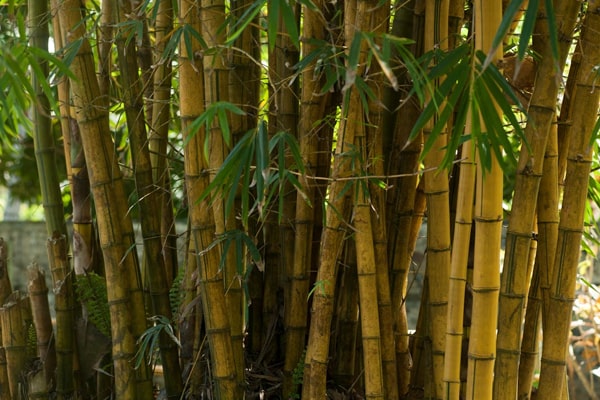Facing a bamboo invasion in your garden? This guide provides a concise blueprint for tackling the challenge head-on. From the rapid spread and damage caused by bamboo to eco-friendly eradication strategies—including manual removal, barrier installation, and continuous monitoring—we cover essential steps to reclaim your garden’s harmony. Dive into effective techniques to control this invasive plant while preserving the environment and your garden’s ecosystem.
Issues Caused by Bamboo

- Bamboo, while a popular plant for its fast growth and aesthetic appeal, can become a significant problem if it invades your garden or yard and different types of bamboo have different impacts on the space. Here are some of the issues associated with bamboo invasion:
- Aggressive Growth: Some species of bamboo, particularly those classified as running bamboo, have a highly invasive root system known as rhizomes. These can spread quickly underground, far beyond the area you intended for the bamboo to grow, invading other parts of your garden.
- Difficult to Control: Once established, bamboo can be very difficult to remove. Its rhizomes can spread deep and wide, and removing them requires significant effort and often professional help.
- Damage to Structures: Bamboo can cause damage to pathways, foundations, and walls as its strong rhizomes grow beneath them, pushing upwards and causing cracks or upheavals.
- Outcompetes Other Plants: Bamboo can grow much faster than most other garden plants and can quickly overshadow them, competing for sunlight, water, and nutrients. This can stunt the growth of your other plants or even kill them.
- Water and Nutrient Hogging: Bamboo is known for its high water and nutrient requirements. Its dense root system can take up a lot of the available water and nutrients in the soil, leaving less for neighboring plants.
- Difficult to Eradicate: Removing bamboo often requires multiple efforts. Cutting down the visible parts of the plant will not kill it; the underground rhizomes will continue to grow. Chemical treatments can be harmful to the environment and other plants, and physical removal is labor-intensive and not always successful on the first attempt.
- Potential for Legal Issues: If the bamboo spreads to neighboring properties, it can lead to disputes and legal issues. In some areas, there are regulations regarding the planting and management of invasive bamboo species to prevent such problems.
How to Deal with a Bamboo Invasion

Dealing with a bamboo invasion in your garden in an eco-friendly manner requires a combination of physical removal, barrier installation, and careful monitoring to prevent its spread. Here’s a step-by-step guide on how to tackle this challenge:
Manual Removal:
- Digging Up: Start by digging up the bamboo rhizomes (underground stems) with a shovel or a garden fork. It’s crucial to remove as much of the root system as possible because any leftover pieces can regrow.
- Mowing or Cutting: Regularly mow or cut the bamboo shoots as soon as they appear. This method starves the plant of energy stored in the roots, weakening the bamboo over time. However, this process can take a couple of years of diligent cutting to be effective.
- Barriers:
- Rhizome Barrier Installation: Install a bamboo rhizome barrier around the area where you want to contain the bamboo. The barrier should be made of a durable material like thick plastic and should be at least 30 inches deep to prevent the rhizomes from spreading beneath it. Overlap the edges of the barrier by at least 2 feet to prevent the bamboo from finding a way through.
Mulching:
- Deep Mulching: After cutting down the bamboo, apply a deep layer of mulch (about 8-12 inches) over the area. This can suppress new growth and make it easier to spot and remove any new shoots that manage to break through.
- Water Management:
- Reduce Watering: Bamboo thrives in moist conditions, so reducing watering around the invaded area can help stress the plants and slow their growth. However, ensure this does not negatively impact other plants in your garden.
- Natural Deterrents:
- Introduce Natural Predators: Although this method is more situational, introducing natural predators of bamboo, such as certain types of insects or grazing animals (if practical), can help control the population.
- Regular Monitoring:
- Inspect Regularly: Even after you think you have removed the bamboo, continue to inspect the area regularly for any signs of new growth. Early detection makes removal much easier.
- Avoid Chemical Herbicides:
- While chemical herbicides can be effective, they are not eco-friendly and can harm surrounding plants and wildlife. If you must use them as a last resort, opt for the least toxic option and use them sparingly and targeted.
- Community Approach:
- If the bamboo invasion extends beyond your garden, work with your neighbors to address the issue collectively. Bamboo can easily spread from one property to another, so a community effort is more effective, though costs can be higher.
Remember, patience and persistence are key when dealing with bamboo invasions eco-friendly. It might take several seasons to completely eradicate the bamboo, but these methods ensure minimal impact on the environment and surrounding ecosystems.



